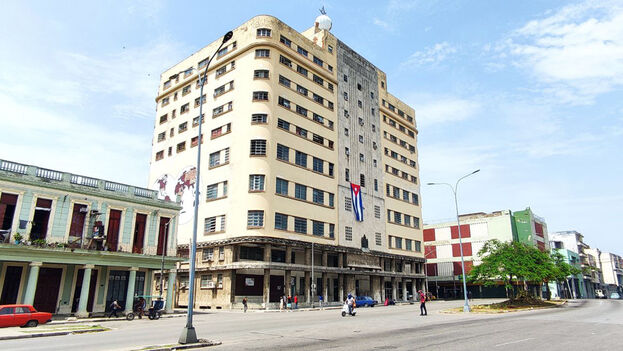
![]() 14ymedio, Xavier Carbonell, Salamanca, 18 November 2022 — The book, Del templo al temple. Silencios y escándalos de la masonería cubana [From Temple to Temple. Silences and Scandals of Cuban Freemasonry] (Editorial Primigenios, 2022), by journalist Camila Acosta, will be presented from November 18 to 20 at the Miami Book Fair. It’s a history of the Masonic order on the Island, which details in a special way the order’s vicissitudes after 1959.
14ymedio, Xavier Carbonell, Salamanca, 18 November 2022 — The book, Del templo al temple. Silencios y escándalos de la masonería cubana [From Temple to Temple. Silences and Scandals of Cuban Freemasonry] (Editorial Primigenios, 2022), by journalist Camila Acosta, will be presented from November 18 to 20 at the Miami Book Fair. It’s a history of the Masonic order on the Island, which details in a special way the order’s vicissitudes after 1959.
Acosta’s research, which had as its background a documentary that she recorded for her graduation thesis at the University of Havana, is presented as the reverse of the story that the regime — in the figure of historians such as Eduardo Torres Cuevas — has attributed to Cuban Freemasonry.
In the back-cover note, the writer and Freemason Ángel Santiesteban Prats points out that the book allows access to a history that “had been extinguished for six decades because that was decided by Fidel Castro,” and he affirms that Acosta has provided a “response to the censorship of the totalitarian regime” on the circumstances in which the order was forced to operate after the revolutionary triumph.”
“Camila Acosta entered a world forbidden to those outside the Masonic fraternity,” continues Santiesteban, who also regrets that the “majority of the Masons themselves barely knew about their own history.”
In a volume of 422 pages that is now for sale on Amazon, Acosta reviews the historiographic tradition that precedes the order and provides details about the female branch, the Daughters of the Acacia, and about the Masons who, in turn, have participated in movements opposed to the Government.
Criticizing the material she addresses, Acosta defines the post-1959 stage as the “decay of Cuban Freemasonry.” From one of the nations with the greatest presence and influence of the order worldwide — with more than 34,000 members — it became one of the weakest in its context. Confiscations of property, infiltrations and aggressive propaganda against its postulates were part of Castro’s strategy to dismantle Cuban Freemasonry.
Obsessed with the possibility that institutions such as fraternities, secret orders and churches would form an opposition front, the Revolution launched systematic attacks on the Masonic infrastructure and threatened young people not to join its ranks.
The exile of many Cubans — including numerous Masons — between 1959 and 1970 is another cause for the decay of the order, says Acosta. Those who remained in the country were forced to report to the Government who attended the meetings, what issues were discussed and who espoused them, as well as “deliver copies of the minutes” and “pay heavy fines for not doing so or delaying,” she says.
“The very fact of belonging to Masonry or some fraternal or religious institution was interpreted by the authorities as a symptom of lack of revolutionary devotion,” Acosta explains in the ninth chapter of her book, which details the schism that the order experienced when it tried to move the headquarters of the Great Lodge of Cuba to Florida.
From the more or less intense persecution of those years, the Cuban Freemasonry organized different initiatives such as the Clandestine Masonic Movement, with expressly anti-communist guidelines.
After several decades of tension, with the arrival of the so-called Special Period, after the collapse of the Soviet Union and the loss of its financial support, and the return of Cubans to religion and other related practices, Freemasonry experienced a boom in membership. However, in 2011, the program Razones de Cuba [Cuba’s Reasons] revealed the complicity of former Masonic Grand Master José Manuel Collera Vento with State Security, which increased disappointment with the order and suspicion among its members.
This episode triggered numerous difficulties and tensions between the Government and the order, and exposed the constant “manipulations” — in Acosta’s opinion — that Freemasonry suffered at the hands of the Office of Religious Affairs of the Communist Party.
The most recent stage in the history of the order, including the imprisonment of several Freemasons during the so-called Black Spring of 2003, or the letter signed by the Masonic Grand Commander to Miguel Díaz-Canel against the police repression of 11J [the protests of 11 July 2021] are also addressed by the journalist in her investigation.
Acosta, born on the Isla de la Juventud [Isle of Youth] in 1993, is a correspondent for the Spanish newspaper ABC in Havana and writes for several independent media. From Temple to Temple was published by Primigenios, a Cuban publishing house based in Miami with a catalogue of almost 500 titles, directed by the writer Eduardo Casanova Ealo.
Translated by Regina Anavy
____________
COLLABORATE WITH OUR WORK: The 14ymedio team is committed to practicing serious journalism that reflects Cuba’s reality in all its depth. Thank you for joining us on this long journey. We invite you to continue supporting us by becoming a member of 14ymedio now. Together we can continue transforming journalism in Cuba.
